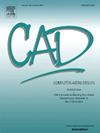基于拓扑优化结果的三轴数控加工参数化模型自动生成方法
IF 3.1
3区 计算机科学
Q2 COMPUTER SCIENCE, SOFTWARE ENGINEERING
引用次数: 0
摘要
将拓扑优化结果转换为参数化模型对于制造轻量化、高刚度产品至关重要。然而,目前可用的技术无法有效地自动化和执行这种转换,特别是对于三轴数控加工。为了弥补这一差距,本研究提出了一种从拓扑优化结果自动生成参数模型的方法。首先,结合三轴数控加工的加工特点,进行曲面体素可及性分析和不同体素聚类,确定(常用)原材料模型的最优加工方向和可拆卸几何形状;然后,提出了一种可移动几何图形的参数化素描轮廓生成方法。这也为通过向原材料模型添加减法特征来生成参数化模型提供了必要的准备。为了保证最终的参数模型尽可能地保留拓扑优化结果的形状,提出了一种分类分层投影方法。该方法可以逐层将可移动几何图形投影并拟合到二次曲线草图轮廓中。根据每一层的草图轮廓,可以生成相应的减法特征,并将其添加到原材料模型中,以去除相应的可移动几何形状。逐层执行此减法过程,可生成拓扑优化结果的最终参数化模型。其中,在相减过程中还实施了一定的约束,以确保最终模型能够保持拓扑优化结果的刚度。最后,对两个复杂且具有代表性的拓扑优化结果进行了自动转换实验,结果表明,当对生成的两个参数模型的变化进行平均计算时,与原始拓扑优化结果相比,最大位移(即柔度)平均减少了19.3%,质量平均增加了45.2%,体积平均增加了28.4%。方法比较还表明,该方法具有特殊的优点,包括能够自动有效地将拓扑优化结果转换为参数化模型,同时保持刚度并可进行三轴数控加工。本文章由计算机程序翻译,如有差异,请以英文原文为准。
An automatic approach for generating parametric models from topology-optimization results for three-axis CNC machining
Converting topology-optimization results into parametric models is crucial for manufacturing lightweight, high-stiffness products. However, currently available technologies cannot effectively automate and perform this conversion, especially for three-axis CNC machining. To bridge this gap, this study proposes an automatic approach for generating parametric models from topology-optimization results. First, integrating the machining characteristics of three-axis CNC machining, surface voxel accessibility analysis and different voxel clustering are carried out to determine the optimal machining directions and removable geometry of the (common) raw material model. Then, a parametric sketch contours generation method is presented for the removable geometry. This also provides the essential preparation for generating a parametric model by adding subtractive features to the raw material model. Particularly, a classified layered projection method is developed to ensure the final parametric model preserves the shape of the topology-optimization result as much as possible. This method can project and fit the removable geometry into quadratic curve sketch contours in a layer-by-layer scheme. Based on the sketch contour of each layer, the corresponding subtractive feature can be generated and added to the raw material model to remove the corresponding removable geometry. Performing this subtractive process layer by layer can generate the final parametric model of the topology-optimization result. Herein, certain constraints are also implemented during the subtractive process to ensure that the final model can preserve the stiffness of the topology-optimization result. Finally, the automatic conversion experiments on two complex and representative topology-optimization results show an average reduction of 19.3 % in maximum displacement (i.e., compliance) and an average increase of 45.2 % in mass as well as 28.4 % increase in volume when averaging the changes across both generated parametric models compared with their original topology-optimization results. The methodological comparisons also show that the presented approach has special benefits, including the ability to convert topology-optimization results automatically and effectively into parametric models, while maintaining stiffness and being processable by three-axis CNC machining.
求助全文
通过发布文献求助,成功后即可免费获取论文全文。
去求助
来源期刊

Computer-Aided Design
工程技术-计算机:软件工程
CiteScore
5.50
自引率
4.70%
发文量
117
审稿时长
4.2 months
期刊介绍:
Computer-Aided Design is a leading international journal that provides academia and industry with key papers on research and developments in the application of computers to design.
Computer-Aided Design invites papers reporting new research, as well as novel or particularly significant applications, within a wide range of topics, spanning all stages of design process from concept creation to manufacture and beyond.
 求助内容:
求助内容: 应助结果提醒方式:
应助结果提醒方式:


